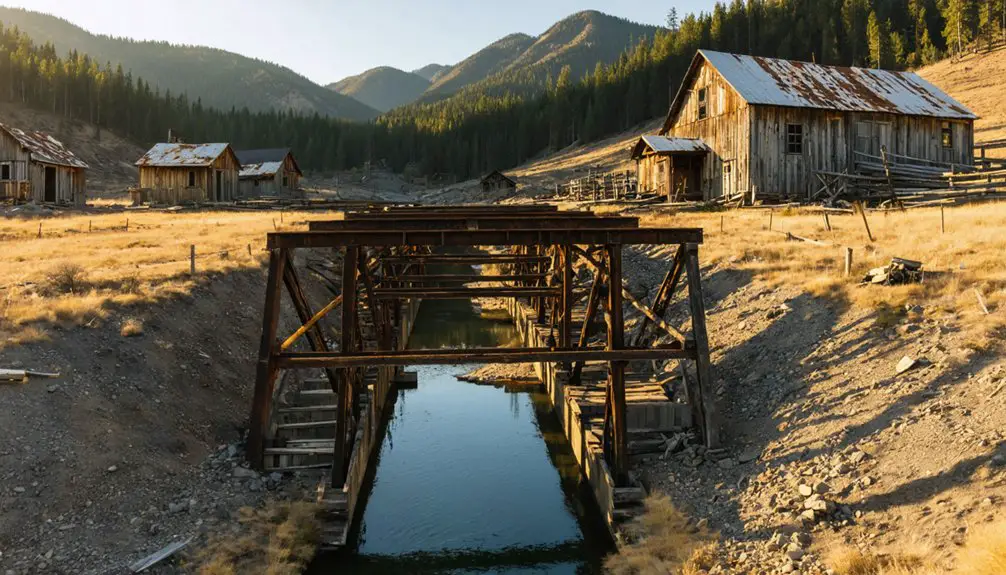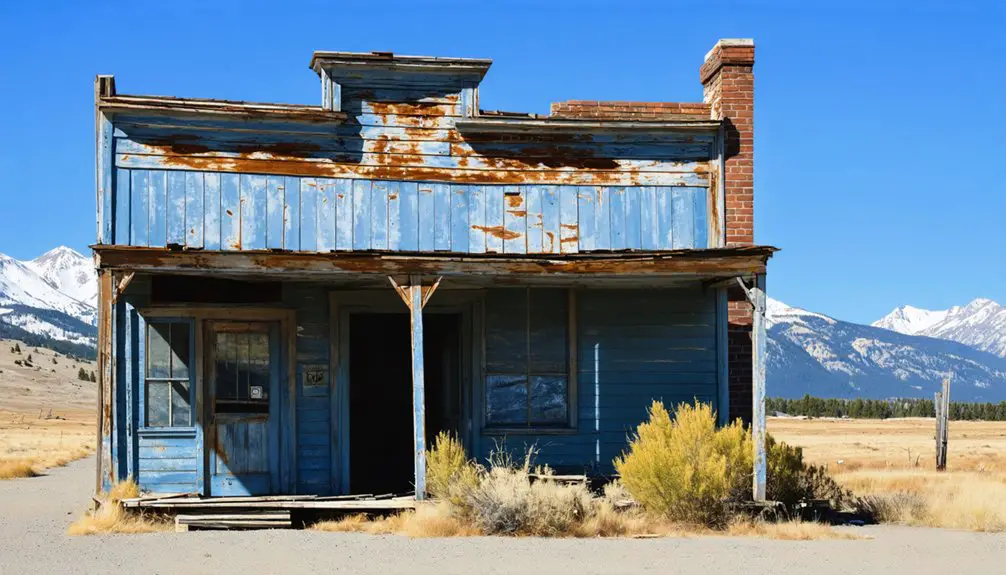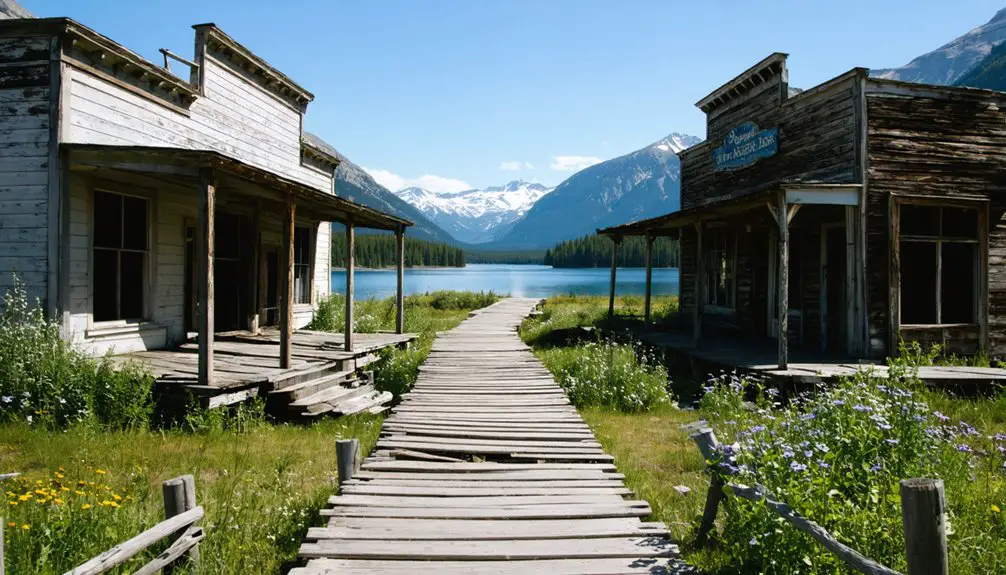You’ll find Conconully nestled in Washington state’s mining country, where silver dreams once attracted 500 residents in the late 1880s. After the silver crash of 1893 and a devastating flood in 1894, this former county seat nearly became abandoned by the 1930s. Today, you can explore its preserved mining structures, historic buildings, and the Conconully Museum while enjoying the area’s lakes and outdoor recreation. The town’s transformation from bustling mining hub to near-ghost town holds fascinating surprises beneath its surface.
Key Takeaways
- Conconully nearly became a ghost town after the 1893 silver price crash forced mine closures and devastated the local economy.
- The town’s population plummeted from its peak of 500 during the mining boom to near-abandonment by the 1930s.
- Unlike neighboring mining settlements that became ghost towns, Conconully survived by transitioning to agriculture through irrigation development.
- The Fourth of July Mine’s brief reopening from 1958-1964 marked the last significant mining activity in Conconully.
- Today, Conconully preserves its ghost town heritage while functioning as a tourist destination with historic structures and outdoor recreation.
The Birth of a Mining Boom Town
When the Columbia Reservation dissolved in 1884, it sparked a transformative period for the Conconully area, leading to the formal opening of mining claims on May 1, 1886.
You’ll find the settlement history began on lands previously inhabited by Interior Salish peoples, who named the area “Conconully,” meaning “money hole” in their language.
Despite mining challenges like fractured ore veins limiting success, the town grew rapidly. Originally called Salmon City, settlers renamed it Conconully in 1888 to reflect its mining identity. As mining declined, the community adapted by transitioning to farming and ranching operations.
The boom attracted diverse residents, swelling the population to 500 at its peak. By 1889, you’d have found a thriving county seat with daily stagecoach service, wagon roads connecting to neighboring towns, and bustling activity around key mines like Mohawk, Leuena, Columbia, and Tough Nut.
The town was severely impacted by economic hardships during the Panic of 1893, along with devastating floods and fires that challenged its survival.
From Silver City to Ghost Town: The Mining Decline
While you’d have found Conconully bustling with silver mining activity in its early days, the catastrophic drop in silver prices to 90 cents per ounce in 1893 brought that prosperity to an abrupt halt.
The Panic of 1893 severely impacted mining operations across Okanogan County, leading to widespread closures and economic hardship.
Despite attempts to revive operations in the early 1900s, including deeper explorations reaching 1,000 feet at mines like the Columbia and Arlington, these efforts proved unsuccessful.
The complex geology of faulted quartz veins, combined with the Great Depression‘s devastating economic impact, transformed this once-thriving mining town into a near-ghost town by the 1930s.
Mining’s Early Promise
During the early mining boom of the 1890s, Conconully’s silver deposits sparked tremendous optimism among prospectors and investors. Through intensive geological exploration and silver mining techniques, workers extracted 1,000 tons of precious ore valued at $25,000 by summer 1893. However, a devastating flash flood in May 1894 destroyed 42 buildings and disrupted mining operations.
Located in the productive Okanogan region, Conconully established itself as one of Washington’s most promising silver mining areas. You’d find the most promising operations at the Mohawk, Leuena, and Columbia mines on Mineral Hill, along with the Tough Nut mine near Salmon Creek.
The region’s rich silver veins, embedded in metamorphic rock formations, yielded impressive grades reaching 18 ounces per ton in some areas. Miners developed an extensive network of underground workings, spanning 4,500 feet of shafts, drifts, and crosscuts that exposed veins across 540 vertical feet.
The Washington Reduction Company’s concentrator processed this valuable ore, cementing Conconully’s reputation as a significant mining center.
Silver Price Crash Impact
The catastrophic silver price crash of 1893 devastated Conconully’s mining industry, sending prices plummeting to 90 cents per ounce and forcing most operations to shut down.
You’ll find that this economic downturn hit surrounding camps even harder, with Loup Loup City and Ruby City becoming virtual ghost towns overnight.
While neighboring mining communities collapsed, Conconully managed to weather the storm better than most, thanks to its diversification into farming.
The silver mining operations that defined the region’s early prosperity struggled against multiple challenges – from the lack of railroad access to the difficulties of processing low-grade ore.
Though some mines attempted comebacks around 1900, including the Columbia and Arlington operations, these revivals proved short-lived. The Fourth Of July Mine would later reopen from 1958-1964, generating approximately $12,000 in revenue.
Failed Deep Mining Attempts
Despite remaining mineral deposits in the Conconully region, attempts to revive deep mining operations in the early 1900s met with consistent failure.
You’ll find records of two major mining feasibility attempts around 1915, when prospectors explored silver-bearing veins at depths reaching 1,000 feet. These ventures proved unsuccessful due to complex geological challenges, including overturned folds, thrust faults, and a westward-projecting gneiss dome that made ore extraction particularly difficult.
The low-grade ore‘s resistance to standard treatment methods further complicated operations. Even Professor Francis A. Thomson’s experimental processing techniques couldn’t overcome the metallurgical hurdles posed by the mixed metals.
With many original mine workings caved in or inaccessible by 1915, the technical difficulties of extracting and processing ore efficiently sealed the fate of Conconully’s deep mining ambitions.
Native American Heritage and Town Naming
Nestled within traditional Interior Salish territories, Conconully’s name reveals deep connections to Native American heritage through two distinct interpretations.
You’ll find one meaning traces to “money hole,” reflecting the area’s rich beaver populations that Indigenous peoples trapped and traded with Hudson’s Bay Company. The other derives from “Con-Con-Ulps,” meaning “cloudy,” originally referring to Salmon Creek.
The name’s cultural significance runs deep through Indigenous history, as the region’s waterways and foothills sustained Interior Salish communities for thousands of years. The construction of Conconully Reservoir Dam transformed the landscape while expanding agricultural opportunities in the early 1900s.
While the Confederated Tribes of the Colville Reservation and Yakama Nation maintain connections to these ancestral lands today, federal policies like the Dawes Act and broken treaties dramatically altered Native Americans’ relationship with their traditional territories.
Federal Projects and Infrastructure Development

Following decades of local advocacy, Conconully secured a landmark federal irrigation project in 1905 when Secretary of the Interior Ethan A. Hitchcock authorized $500,000 for Washington state’s first federal reclamation venture. The project promised to transform over 7,000 acres of arid land into fertile farmland.
You’ll find the Bureau of Reclamation’s pioneering spirit in the construction of Conconully Dam, which began in 1907. As their first hydraulic fill dam, engineers had to design the plant on-site, using materials from nearby Peacock Mountain.
The irrigation infrastructure expanded from small ditches to an extensive network that would eventually reclaim up to 75,000 acres. This federal investment reshaped Conconully’s destiny, enabling farmers to grow corn, potatoes, grain, and establish thriving orchards around Pogue Flats. The town served as the county seat before declining mining interests shifted administrative power elsewhere.
Agricultural Transformation and Water Resources
You’ll find Conconully’s economic shift from mining to agriculture was driven by strategic irrigation development, starting with small ditches that evolved into an extensive water management system.
The construction of Conconully Reservoir Dam in 1907 marked a turning point, enabling the irrigation of roughly 2,000 acres for orchards and diverse crops. Early pioneers like L.H. Mason entered the general merchandise business there in 1887, supporting the growing agricultural community.
This change to irrigated farming transformed the region’s landscape, as larger homesteads were divided into smaller, more manageable plots limited to 40 acres each under federal regulations.
Irrigation Reshapes Local Economy
As Conconully’s mining economy declined in the early 1900s, the development of irrigation infrastructure marked a pivotal shift toward agricultural production.
You’ll find evidence of this transformation in the Conconully Dam’s 1910 completion and the intricate network of canals built between 1911 and 1917.
Yet irrigation challenges quickly emerged.
You’d have seen water supplies running dry by August, and seepage from unlined canals caused significant losses.
While the project initially aimed to irrigate over 7,000 acres, agricultural sustainability proved difficult, forcing a reduction to about 5,000 acres.
Many orchardists abandoned their dreams when drought years hit after 1915.
Those who stayed adapted by diversifying into hay and forage crops alongside fruit production, though sandy soils and inconsistent water supplies remained persistent obstacles.
By 1954, the region had become a major apple-growing center with 626,677 apple trees.
From Mines to Farmland
While silver mining operations crumbled in 1893 due to plummeting prices, Conconully’s resourceful residents turned to agriculture for economic survival.
You’ll find that their agricultural innovation centered around the construction of the Conconully Reservoir Dam in 1907, which revolutionized farming in this arid region. The dam’s advanced irrigation technology allowed farmers to transform previously unworkable land into productive fields of corn, potatoes, grain, and hay.
You can trace how this shift from mining to agriculture brought stability to the area. The reservoir’s dual purpose of flood control and water storage guaranteed year-round irrigation, while protecting valuable farmland.
This masterful management of water resources turned what could’ve been another abandoned mining town into a thriving agricultural community.
Historical Buildings and Architectural Legacy

Once a bustling mining boomtown established in 1886, Conconully’s architectural legacy reflects its evolution from a tent city to a more permanent settlement.
You’ll discover a rich tapestry of architectural styles spanning from early log cabins to New Deal-era buildings, though many original structures fell victim to a devastating 1893 fire.
- The 1903 Methodist church stands as one of the town’s oldest preserved buildings
- CCC buildings from 1937-38 showcase classic Forest Service architecture
- Stone foundations of former commercial buildings dot the landscape
- Early residential structures evolved from simple log cabins to frame houses
- The Conconully Museum, housed in a historic building, preserves the town’s architectural heritage
These surviving structures tell the story of a community that adapted its building practices as it transformed from a mining camp to an established town.
The Photography of Frank Matsura
In 1903, Japanese photographer Frank Matsura arrived in Conconully and began documenting frontier life while working as a cook’s helper at the Elliott Hotel. For four years, he developed photos in the hotel’s laundry before establishing his own studio in Okanogan.
Matsura’s influence on cultural documentation can’t be overstated. His work captured the region’s diverse aspects – from pioneer families to Indigenous peoples, cattle drives to community events.
Through his lens, Matsura preserved a pivotal moment of cultural transformation, documenting both settlers and Native Americans during a changing era.
You’ll find his most significant contributions in his portraits of Syilx (Okanogan) communities, which showed them adapting to changing times rather than disappearing. Using a 5-by-7 view camera, he created high-resolution images that earned recognition at the 1909 Alaska-Yukon-Pacific Exposition.
Though he died in 1913, his photographs remain a crucial historical record of early 20th-century frontier life in Washington.
Natural Beauty and Recreational Opportunities

Surrounded by pine-fringed ridges and pristine wilderness, Conconully Lake anchors the region’s recreational opportunities with its crescent-shaped reservoir and 12-acre state park.
You’ll discover outdoor adventures at elevations ranging from 850 to 8,200 feet, offering diverse terrain for year-round exploration.
- Trek to the historic Crow’s Nest lookout on Funk Mountain for panoramic scenic vistas of the lake and surrounding landscapes
- Navigate the unique snowmobile-friendly streets in winter, with access to pristine backcountry trails
- Camp alongside the lake in the city park, immersed in the natural mountain setting
- Fish in two nearby lakes teeming with regional species
- Explore the dense pine forests and rolling grasslands of the 525-square-mile former mining district
Modern Tourism and Heritage Preservation
Though Conconully’s mining heyday has passed, this historic town now thrives as a heritage tourism destination, anchored by its museum on Lottie Avenue and preserved Civilian Conservation Corps buildings.
You’ll discover a community deeply committed to preservation initiatives, maintaining historic mining structures and cabins that tell the story of the 1890s gold rush era.
The town’s two fishing lakes, including the 313-acre Conconully Lake, offer excellent trout and bass fishing.
Anglers flock to Conconully’s twin lakes, where pristine waters teem with trophy trout and bass year-round.
Modern amenities like boat launches, campgrounds, and trails support your outdoor adventures.
Several resorts cater to visitors seeking both natural beauty and historical exploration.
Through guided tours and interpretive signage, you’ll learn about mining disasters, economic shifts, and pioneer life while exploring this transformed mining town that’s found new life through tourism.
Frequently Asked Questions
What Was the Highest Recorded Population of Conconully During Its Peak?
You’ll find it fascinating that after growing from 232 residents in 1890, the population peaked at 357 in 1910, marking a period of significant historical growth before declining sharply in subsequent decades.
Are There Any Reported Ghost Sightings or Paranormal Activity in Conconully?
You won’t find documented ghost stories or paranormal investigations from this location in official records. While it’s a ghost town by definition, there’s no verified evidence of supernatural activity.
What Happened to the Original Mining Equipment and Machinery?
Like scattered breadcrumbs, the mining legacy vanished when companies sold or scrapped their equipment. You won’t find much original machinery – it was systematically dismantled, salvaged, or removed between the 1940s-1960s.
How Many Buildings From the Original Town Are Still Standing Today?
You’ll find several original buildings standing today through historic preservation efforts, though exact counts aren’t documented. Recent town restoration work has helped maintain a cluster of structures in the mountain cup area.
Can Visitors Still Pan for Gold in Salmon Creek?
All that glitters isn’t always forbidden! You can pan for gold in Salmon Creek using non-motorized equipment like pans and small sluice boxes, as long as you follow state regulations protecting fish.
References
- https://revisitwa.org/waypoint/conconully/
- https://www.conconully.com/museum
- https://www.dnr.wa.gov/publications/ger_ic49_conconully_mining_dist.pdf
- https://okanogancountry.com/ghost-towns
- http://www.ghosttownsusa.com/okanco.htm
- https://parks.wa.gov/about/news-center/field-guide-blog/conconully-state-park-history
- http://www.ghosttownsusa.com/bttales50.htm
- https://pubs.usgs.gov/bul/0640b/report.pdf
- https://pubs.usgs.gov/bul/1402/report.pdf
- https://www.historylink.org/file/7608



